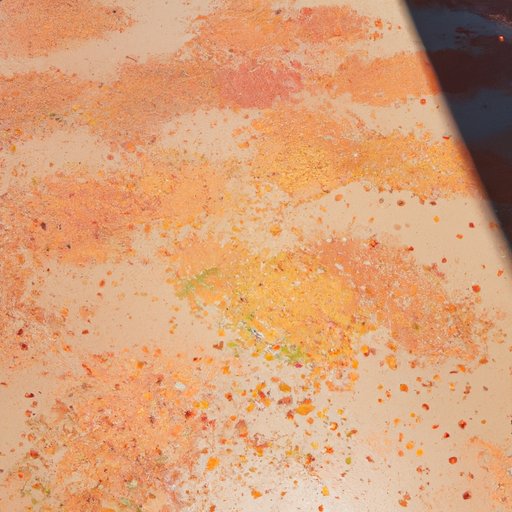I. Introduction
Having a plain concrete patio can be uninspiring. If you’re looking to add color and texture to your outdoor space, then staining your concrete patio is a great option. Not only does it improve the appearance, but also adds durability and a non-slip surface. In this article, we will guide you through the process of how to stain a concrete patio.
II. Step-by-Step Guide: How to Stain a Concrete Patio
A. Materials Needed
Before starting, gather the necessary materials including a pressure washer, concrete cleaner, patching compound, garden sprayer, acid/water-based stain, sealer, and a roller applicator.
B. Preparation
The first step is cleaning the patio surface using a pressure washer and concrete cleaner. Repair any cracks or chips with a patching compound. Allow the surface to dry completely before moving onto the next step.
C. Applying the Stain
Apply the stain using a garden sprayer or roller applicator. Begin with a light coat and gradually add layers until the desired color is achieved. Avoid drips or bubbles by applying in a consistent and even manner.
D. Achieving the Desired Look
Customize the color and texture of the stain using techniques like scored lines, stenciling, and gradations. Experiment with different shades and patterns to find your ideal look.
III. Best Stains for Concrete Patios
A. Types of Stains
There are two main types of stains: acid-based and water-based. Acid stains generate a marble-like finish while water-based stains offer a more opaque look.
B. Pros and Cons
Acid stains yield a natural appearance but can be difficult to work with. Water-based stains provide a wider range of color options, although their opaque finish means they will not achieve the same marble-like effect.
C. Selecting the Best Stain
Factors to consider when selecting a stain include color preference, longevity, and weather resistance. The choice of stain should be based on compatibility with the patio’s location, ensuring that it won’t fade or deteriorate quickly.
IV. DIY vs Professional Staining
A. Cost Comparisons
DIY staining can save you a significant amount of money compared to hiring a professional.
B. Safety Considerations
Wearing protective gear like gloves, eye protection, and a mask is essential when working with stains. Proper ventilation is also required to avoid inhaling hazardous fumes.
C. Level of Expertise Required
Hiring a professional provides a guarantee of a well-done job but can be more expensive. DIY staining can be challenging, but with the right resources and techniques, it can be done successfully.
V. Stain Patterns and Designs
A. Inspiration
There are various ways to customize your stained concrete patio with patterns and designs. Research different ideas or consult with an expert for inspiration.
B. Recreating Designs
Popular patterns include brick, tile, and flagstone. To recreate, purchase stencils or tape and use a contrasting stain color.
C. Customization Tips
For designs that match your taste, add personal touches like initials or your favorite sports team’s logo.
VI. Maintenance and Care
A. Resealing Instructions
Concrete patios should be resealed every two years to maintain their appearance and longevity.
B. Spot Treating Stains
Recurring stains like grease, oil, and rust can be spot-treated with a cleaning solution made of baking soda and water or vinegar and water.
C. Preventing Damage
Maintain the quality of your stained concrete patio by applying a coat of sealer after cleaning and avoiding heavy foot traffic and harsh weather elements.
VII. Conclusion
In conclusion, staining your concrete patio is an easy and affordable way to improve its appearance and durability. Determine which type of stain is best for your patio based on factors such as color preference and longevity. Whether you opt for a DIY approach or a professional service, always keep in mind the importance of safety measures while handling stains.
With the right tools and techniques, along with a healthy dose of creativity, you can transform a plain concrete patio into a stunning and functional outdoor space.
